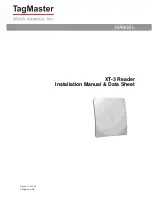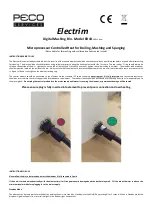
Motion Overview
410
Feed Forward
Acts to “push” the commanded output ahead to reduce or eliminate dynamic following error. Where
dynamic following error is defined as the difference in actual position to commanded position that
exists during motion. It is a more pure term than integral gain. It could be defined as the ability to
correct for a “lag” in the system with an effect similar to Proportional Gain. Do not increase feed
forward gain to the extreme as it can result in positive following error and excessive overshoot.
Velocity Gain
When using a current loop amplifier, the internal velocity loop in the control can be used to provide
dampening without an external tachometer.
Using the internal velocity loop with a current loop amplifier can result in higher static stiffness,
smoother machine motion, and less overshoot.
4) Recommended Tuning Procedures for Hypertherm Automation Motion Controls
Using the information previously provided as a core understanding of the position loop process, we
can now look at tuning motion for the desired motion performance. Due to potential safety hazards
and the potential possibility for machine damage from incorrect tuning, it is recommended that this
operation be performed by trained and experienced personnel.
Prior to performing motion tuning, values for DAC Polarity, Encoder Polarity and maximum machine
speed should be calculated and entered into control setups. Servo Error Tolerance for the axes
should be set to maximum (5 inch max for X/Y motion).
Initially, it is recommended that basic tuning start with the motors disengaged from the machine to
allow the user to confirm controlled motion and response of the motion axes. An initial Acceleration
Rate of 10 Mg‟s can be used to begin the motion tuning. It is important to remember that after the
motors are engaged to the machine for motion, the load requirements for each axis will change
requiring additional tuning. Additionally, if the acceleration rate is increased after the initial tuning,
additional adjustments to Gain tuning may be required for proper machine motion.
Procedure for Velocity Type Drives
We recommend tuning the system by performing manual moves at a slow speed with all gains set to
zero with the exception of Proportional Gain. Proportional Gain should start with a small value of 10.
Engage the motors to the machine frame and beginning raising the Proportional Gain to allow
movement. If the axes start to vibrate or oscillate, this indicates the selected gain value is too high
and should be lowered. It may also require de-tuning the response of the Drive amplifier.
Now that you have some basic control of the system, set up the Watch Window to display Position
and Following Error for the selected Axes. Load and automatically “Trial” the Test Pattern simple
shape from the shape library. You will be able to follow the response of the system by watching the
performance of the Motor /Encoder feedback and its ability to maintain path on the control preview
screen.
Systematically increase Proportional Gain until it has little or no effect on the following error or until
instability becomes noticeable. Then reduce Proportional Gain to eliminate instability. Derivative Gain
may be used to provide a dampening effect. For a Velocity Loop Servo Drive, Integral Gain should
be set to zero. After tuning for the best response, increase Feed Forward Gain systematically to
further reduce following error if necessary. It is not required that you eliminate following error but it is
wise to ensure that Following Error for each axis is similar. Please Note: Feed Forward Gain will
reduce steady state following error, but may cause overshoot.
Summary of Contents for Edge TI
Page 24: ...Table of Contents XXII...
Page 41: ...Overview 17 Alpha Numeric Keypad Numeric Keypad...
Page 54: ...Overview 30...
Page 83: ...Setups 59 Water Jet Press the Timing Diagram soft key to view the timing diagram from setups...
Page 88: ...Setups 64...
Page 116: ...Shape Manager 92...
Page 128: ...Files 104...
Page 280: ...Part Options 256...
Page 317: ...Diagnostics 293 DriveTop from Indramat...
Page 402: ...Phoenix Link 378...
Page 420: ...Sensor THC 396...
Page 428: ...Command THC 404...
Page 436: ...Motion Overview 412 Motion Tuning Watch Windows Position and Following Error may be displayed...
Page 470: ...Program Codes 446...
Page 478: ...Automated Plasma Interface 454 Inputs...
Page 479: ...Automated Plasma Interface 455 Inputs...
Page 480: ...Automated Plasma Interface 456 Outputs...
Page 496: ...Automated Plasma Interface 472...
Page 520: ...MicroEdge 496...
Page 532: ...Edge Ti 508 Optional Motor Information...
Page 540: ...Edge Ti 516...
Page 546: ...Voyager III 522 Examples of possible circuits Output Input 24 VDC Com...
Page 557: ...Networking 533 7 Double Click on the network interface connected to your LAN...
Page 558: ...Networking 534...
Page 561: ...Networking 537...
Page 562: ...Networking 538 13 Double click on the System 14 Select the Computer Name tab...
Page 572: ...Networking 548...
Page 573: ......
















































